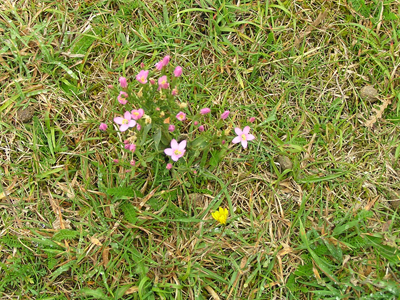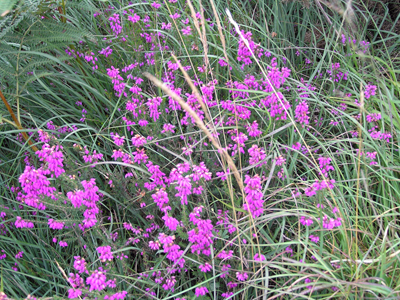Greenlands Farm near Studland on the East Dorset coast near Poole, is one of my ancestral places – but more of that later. It’s also a wonderful landscape, whatever your connections. Here’s the map reference on the Geograph grid.
I visited and took these pictures on a damp day in August 2009.
Greenlands is now a site where the National Trust is undertaking one of the largest heathland restoration projects in the country. It took over the site in 1999.
This place reminds me of the land of a Thomas Hardy novel – although his Wessex stories were based at the other end of Dorset, in the west. Here nature is still bountiful and walking along the lanes between the fruit-laden hedgerows I feel I am in the footsteps of many a Victorian rural heroine. Or maybe just my 3-great grandmother Ann Read, a fisherman/farmer’s daughter who grew up in these acres.
Until the 1950s the area had been heathland for 2,000 years, but its “unique tapestry of wildlife” was lost when the land was ploughed up for agriculture. The soil was fertilised and grass replaced the heather.
Now sheep and cattle are allowed to graze to ensure trees do not establish and it is hoped the fertiliser will eventually wash away and heather will recolonise – it likes only thin, sandy soils.
One heathland bird I did spot on my visit was the stonechat (Saxicola rubicola) – I did not get a very good picture as it was such a grey, damp day, but its stone-on-stone chatter made its identification obvious even though I had never seen one before.
Much of the ancestral information below is from from Ruth Churchill Lancaster, a descendant of my 4-great-grandfather, John Read (born 1778 in Studland) via Harriot Read and Henry Churchill. I am descended from Harriot’s sister Ann, who married Richard Hayes, a fisherman from Poole.
On the 1841 census John Read (Fisherman) is shown as widowed, as his wife Sarah had died (age 63, on 16 June 1836, Studland). He spent that night on Brownsea Island with the newly wedded Henry and Harriot, although he is recorded as a “Fisherman of Greenland”.
The National Trust confirms that back in 1810 John Read was the tenant of the land known as Greenland, being four enclosures of about 10 acres… this prior to his marriage to Sarah on 10 December 1811.
An 1840 tithe map shows that John Read’s holding was a house with a garden and a five-acre arable plot together with some meadow land acreage, he is recorded on the map as landowner and occupier. The remains of this stone house/cottage are now sadly overgrown with woodland.
Greenland is also known as Greenlands and that is what Ruth Churchill Lancaster’s great-grandparents called it. The smaller tenement was later amalgamated with Greenlands Farm itself (according to information from the National Trust archives) and this is confirmed later by the 1861 census which states that Henry Churchill is a farmer of 32 acres, increasing to 35 acres by 1871.
Henry and Harriot brought up all of their seven children at Greenlands Farm, but sadly the oldest daughter, also a Harriot, died aged 14 in 1856 and then his wife Harriot died aged 45 when the youngest child George was just eight years old.
Three years later Henry re-married Hester Squires and went on to have two more children. They all lived at Greenlands Farm.
At this time usually the eldest son would inherit, but oldest son Isaac Churchill was not interested in farming; he was a shipbuilder and metal worker in Southampton, never married and died aged 46 in 1893, leaving Job as the eldest son.
Job had worked alongside his father all his life, earliest occupation as a dairyman, and in 1891 he is recorded as a farmer (rather than a farm worker) as he had now taken over Greenlands Farm from his retired father Henry, who died a few years later in 1897.
Greenlands Farm remained in the family until around 1905, almost a century occupied by the same family. Meanwhile my ancestor Ann was firmly a fisherman’s wife in Poole.





























Hi lovely to see these stunning photos and I am delighted that you have mentioned me in your narrative. We share a unique history. Henry and Harriet (nee Read) lived with Harriet’s father John Read until his death. John left an interesting will. He left his lands, tennanted and owned, to his daughter Harriet, my 3 x gt grandmother and his remaining goods to his other daughter Ann, your 3x gt grandmother. Since we last exchanged emails I have done further research on our Read family, who originated in Swanage and were stone masons. I do have a photo of Henry Churchill, he is buried in Studland Churchyard, Yeoman Farmer of Greenlands, not bad for a farm labourers son from Corfe….but then he married well into the Read family! The original old farmhouse is indeed the stone ruins that you mention above. Im sure John Read, our mutual 4 x gt grandfather would be delighted that we, his descendants, are still sharing the beauty of this land in 2012. Kind regards. Ruth.
Sorry to take so long to reply (SO busy!). I will get back to you by email. I read your comment earlier, but I have only just realised you say the Reads came from stone masons in Swanage! You must let me have the details, as I have never made it beyond John. I already have stonemasons in another ancestral line… Corbens and Webbers. Best wishes…
Hello. I’m also a descendent from this Read family. John Read, James Read, Jane Read, James Vile, George Vial, Henry Noel Vial, John Vial…and me, going through the generations. Thankyou for this interesting article.
Lovely to make contact – what is the farthest back you have reached with John Read’s ancestors? I think I can only go back to John Read (1738).
I have come across the Vials/Viles in my researches. In particular is James Vile, a butcher from Milford in Hampshire, in prison at one point for being insolvent, one of yours?
No “offence”, several of my ancestors had interesting jail stories!
All the best 🙂
Thank you for such an interesting and beautifully illustrated post. I only came across it the other day, as I’d been for a walk over by Greenslades Farm (when we were still allowed out!) and I sent a pic to my brother, who sent me the link to your article.I haven’t really done much family history research, but I’m related to the Churchills in Swanage. My grandfather was Wilfred Churchill, and he married Kathleen Masters in the 1930s I believe.
All the best – Karen
I’m not sure if it’s possible to marry up our trees but I will email you a part of mine with a lot of Churchills descended from Henry Churchill (died 1897) and Harriet Read. I have only gone as far as their grandchildren but it may be the next generation that leads to your Wilfred…
Thanks for commenting – take care 🙂
PS. I don’t know why I called the farm Greenslades…I think it could be because there’s a local fishmonger here with that name…sorry!
Hello, I recently discovered the walks on Studland and have been trying to identify some of the places I found. These include a large area of water at 50°39’39.1″N 1°58’52.0″W a sign nearby suggests this might be an old reservoir. Is that correct? Do you know anything about the Rempstone Estate? Or a source of information? Lovely photos on your website.
I’m afraid I know little as I don’t live in Dorset, despite my ancestry.
I don’t know about the pond but there are lots in the area, probably naturally formed?
You have probably searched Repstone online yourself and found these articles…
https://en.wikipedia.org/wiki/Rempstone_Stone_Circle
https://www.dorsetlife.co.uk/2006/03/a-purbeck-squire/
https://www.visit-dorset.com/things-to-do/rempstone-cycle-ride-p1257393
https://www.bournemouthecho.co.uk/news/15518424.andy-martin-discovers-the-background-to-purbecks-rempstone-estate/
https://www.megalithic.co.uk/article.php?sid=562
https://getoutside.ordnancesurvey.co.uk/local/rempstone-heath-purbeck
https://www.dorsetwildlifetrust.org.uk/news/uks-first-super-national-nature-reserve-created-purbeck-heaths
Thank you so much for visiting my blog – best wishes 🙂
Valery
That map reference is an old clay working, where ball clay was dug 19th & early 20th centuries. The whole of this area has these places where the clay has been removed from.
Thanks Steve – mystery solved! All the best, Valery